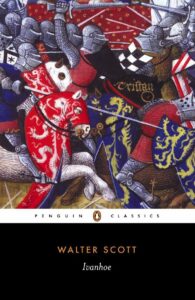
Book Summary
Ivanhoe is an exciting adventure book written by Walter Scott. It takes place in medieval times, which means a long, long time ago when knights and castles were real!
In Ivanhoe, we follow the story of a brave and noble knight named Ivanhoe. He is a hero who fights for justice and helps people in need. Ivanhoe faces many challenges and battles, but he never gives up!
The book is filled with thrilling action scenes, like jousting tournaments and sword fights. You’ll also meet interesting characters like Robin Hood, who steals from the rich to give to the poor, and the wicked Prince John, who wants to take over the kingdom.
Ivanhoe teaches us important lessons about loyalty, friendship, and standing up for what is right. It shows us that even in difficult times, we should always stay true to our values and fight for justice.
The story also gives us a glimpse into what life was like during medieval times. We learn about the customs and traditions of knights, the importance of honor and chivalry, and the power struggles between different groups of people.
Walter Scott, the author of Ivanhoe, was a famous Scottish writer who lived a long time ago. He loved history and wrote many books about knights and adventures. His stories are still loved by readers all around the world today!
“Ivanhoe” is a historical novel by Sir Walter Scott, first published in 1820. Set in 12th-century England, the novel blends historical fact with fiction, revolving around the themes of chivalry, romance, and conflict between the Normans and the Saxons. The story is a rich tapestry of medieval life, filled with knights, tournaments, and the struggle for the English throne.
“Ivanhoe” is a captivating tale that transports readers back to the Middle Ages, a time of knights, castles, and epic battles. The novel is a complex interplay of history and imagination, where Scott masterfully intertwines the lives of his characters with the political and social realities of the time.
The protagonist, Wilfred of Ivanhoe, is a Saxon knight who has been disowned by his father for his allegiance to the Norman King Richard the Lionheart. Despite the odds, Ivanhoe remains loyal to the king and is determined to restore his honor. His love for the beautiful Lady Rowena adds a romantic subplot to the story.
Scott’s vivid descriptions of the jousting tournaments, the siege of Torquilstone Castle, and the characters’ intricate costumes and manners are particularly noteworthy. The novel also features a diverse cast of characters, including the brave and noble Ivanhoe, the villainous Templar Brian de Bois-Guilbert, and the wise and witty jester Wamba.
“Ivanhoe” is more than just a historical novel; it is a commentary on the social and political issues of Scott’s time. The conflict between the Normans and the Saxons symbolizes the struggle for power and identity in a rapidly changing society. Scott uses this historical backdrop to explore themes of loyalty, honor, and the clash of cultures.
The character of Ivanhoe represents the ideal knight, embodying the virtues of chivalry, bravery, and loyalty. However, Scott also presents a critique of these ideals through the character of Rebecca, a Jewish maiden who is arguably the most virtuous character in the novel, despite being marginalized due to her religion and gender.
Scott’s portrayal of the Jewish characters, Rebecca and her father Isaac, is particularly significant. In a time when anti-Semitism was prevalent, Scott challenges these prejudices by depicting them as sympathetic characters who are victims of bigotry and intolerance.
Sir Walter Scott (1771-1832) was a Scottish novelist, poet, historian, and biographer who is often considered both the inventor and the greatest practitioner of the historical novel. His works, which include “Rob Roy,” “The Lady of the Lake,” “Waverley,” and “Ivanhoe,” are renowned for their vivid and detailed descriptions of the Scottish landscape and history.
Scott’s novels were hugely popular during his lifetime and continue to be widely read and studied today. His influence on the historical novel genre cannot be overstated; his blend of history and fiction, his complex characters, and his exploration of social and political themes have set the standard for countless authors who followed in his footsteps.
Don Quixote by Miguel de Cervantes
Miguel de Cervantes
Read Now →